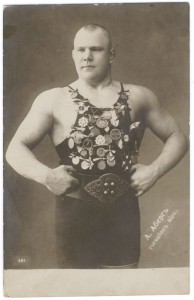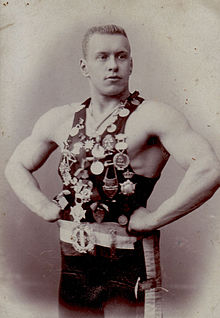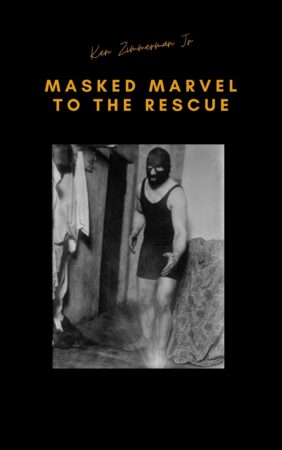Russian Civil War Snags Aberg and Lurich
Estonia gave birth to three of the greatest wrestlers of the first two decades of the 20th Century: Georg Lurich, George Hackenschmidt and Aleksander “亚历克斯” ABERG. As part of the Russian Empire at the time, Estonia contained a number of elementary and high schools with superior physical education programs.
Lurich and Hackenschmidt both started out as weightlifters and transitioned into wrestling. Aberg was a few years younger and focused his talents on wrestling from an early age. All three men practiced the dominant style of European wrestling at the time, Greco-Roman wrestling.

亚历山大 “亚历克斯” ABERG (公共领域)
All three men also had a connection to Frank Gotch. Georg Hackenschmidt, the recognized World Heavyweight Wrestling Champion, lost his title to Gotch in 1908. Hackenschmidt also lost the rematch in 1911. Georg Lurich traveled from Europe in 1912 and lost what would be Frank Gotch’s final match and last title defense in April 1913.
Alex Aberg came to the United States in 1914 hoping to lure Gotch out of retirement or be recognized as the new World Heavyweight Wrestling Champion by winning the 1915 International Wrestling Tournament in New York City.
Georg Lurich and Georg Hackenschmidt were rivals. Lurich击败Hackenschmidt, while he was an amateur. Lurich often bragged about it but stayed clear of a rematch with Hackenschmidt. Neither man cared for the other. Aberg’s friendship with Lurich probably precluded a relationship with Hackenschmidt.
Alex Aberg did win the 1915 International Wrestling Tournament but despite Aberg’s and promoter Sam Rachmann’s best effort, Aberg was not accepted as Gotch’s successor. Joe Stecher defeated American Heavyweight Wrestling Champion Charles Cutler during July 1915. Gotch endorsed Stecher as his successor and was recognized as the new World Heavyweight Wrestling Champion.
Aberg realized a match with Stecher wasn’t in the works, so he and Lurich returned to Europe in 1917. They intended to tour and make money wrestling but World War I intervened. Stanislaus Zbsyzko later claimed that he was to meet his old rival Aberg, who reported Zbsyzko was an Austrian spy to the Russian Imperial Army. Zbyszko claimed Aberg reported him to get out of the match.
Zbyszko was released by the authorities, returned to Poland and made his way back to America. Aberg and Lurich wouldn’t be so lucky.

乔治Lurich从公共领域
原来, Aberg and Lurich were living in relative peace in Russia. As the Bolsheviks took power, they began to target officials and celebrities seen as loyal to the Russian Imperial Army. Reportedly, Aberg and Lurich were on a “death list”.
在 1919, several reports reached America that Aberg and Lurich had been murdered. 然而, the men were living safely in territory still held by the Russian Imperial Army or “Whites”, who were battling the Bolsheviks (The Red Army).
While they were trying to escape Russia, Aberg and Lurich were stranded in a South Russian town named Armavir. The men intended to escape Russia through the Black Sea. At the time they were stranded, Armavir was girpped with typhoid.
The 43-year-old Lurich was tired from several months on the run. He would catch the typhoid fever first. Lurich’s powerful body could not fight off the illness. He died on January 20, 1920.
The 38-year-old Aberg also caught the illneess but did manage to recover from it. 然而, in his weekend state, he caught pneumonia in the winter and died on February 15, 1920. Aberg and Lurich were buried in a single grave in the town’s German cemetery.
Despite professional athletes larger-than-life personas, they are human beings and not immune to bigger conflicts outside of their control. It was a sad end to two great wrestlers.
You can leave a comment or ask a question about this or any post on my Facebook页面.
Sources: Omaha Daily Bee, 五月 20, 1919 版, p. 8
Pin It

